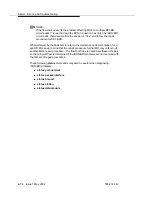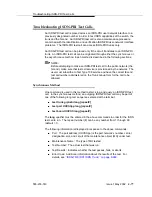
Alarms, Errors, and Troubleshooting
555-233-143
4-88
Issue 1 May 2002
Comparing Packet and TDM Buses
The packet and TDM buses have several similarities and differences. There are
two physical TDM buses in each EPN. One of the buses can fail without affecting
the other, but half of the call-carrying capacity is lost. There is one packet bus in
each PN. A failure of that bus can disrupt all packet traffic in that EPN.
In critical-reliability systems, the Maintenance/Test circuit pack provides
packet-bus reconfiguration capabilities. This allows the packet bus to remain in
service with up to three lead failures. There is no corresponding facility on the
TDM bus. Instead, the second physical TDM bus continues to carry traffic until
repairs are completed.
System response varies according by type of bus failure and whether or not the
failure occurs in an :
■
EPN controlled by an IPSI-connected EPN
In such an EPN, a catastrophic TDM bus failure (one that affects both TDM
buses) disables all traffic in the EPN. A catastrophic packet-bus fault
affects only packet traffic, so that TDM traffic is unaffected, while all
ISDN-BRI, ASAI, and ISDN-PRI signaling traffic is disrupted.
The significance of this distinction depends on the customer’s applications.
A customer whose primary application requires ASAI would consider the
switch to be out of service, while a customer with a:
— Large number of digital/analog/hybrid sets
— Small number of ISDN-BRI sets
would probably not consider the packet-bus fault a catastrophic problem.
The only way an EPN’s packet-bus fault can affect TDM traffic is by
impacting the system’s response time in a large switch while running
ISDN-BRI endpoint maintenance. This should rarely happen because the
Packet Bus maintenance software can prevent this for most faults (see the
next section).
■
IPSI-connected EPN
If a packet-bus fault occurs in an IPSI-connected EPN, the impact can be
more wide-spread. Since an IPSI-connected EPN’s packet bus can carry
the signaling and control links for other EPNs, a packet-bus failure in this
EPN effectively:
— Disrupts the IPSI-connected EPN’s packet-bus traffic
— Removes every subordinate EPN within its scope from service,
including both TDM and packet buses.
!
CAUTION:
Packet-bus fault isolation and correction often involves circuit-pack removal,
which is destructive to service. Minimize time devoted to destructive
procedures by using non-destructive ones whenever possible.
Summary of Contents for S8700 Series
Page 50: ...Maintenance Architecture 555 233 143 1 26 Issue 1 May 2002 ...
Page 74: ...Initialization and Recovery 555 233 143 3 12 Issue 1 May 2002 ...
Page 186: ...Alarms Errors and Troubleshooting 555 233 143 4 112 Issue 1 May 2002 ...
Page 232: ...Additional Maintenance Procedures 555 233 143 5 46 Issue 1 May 2002 ...
Page 635: ...status psa Issue 1 May 2002 7 379 555 233 143 status psa See status tti on page 7 406 ...
Page 722: ...Maintenance Commands 555 233 143 7 466 Issue 1 May 2002 ...
















































